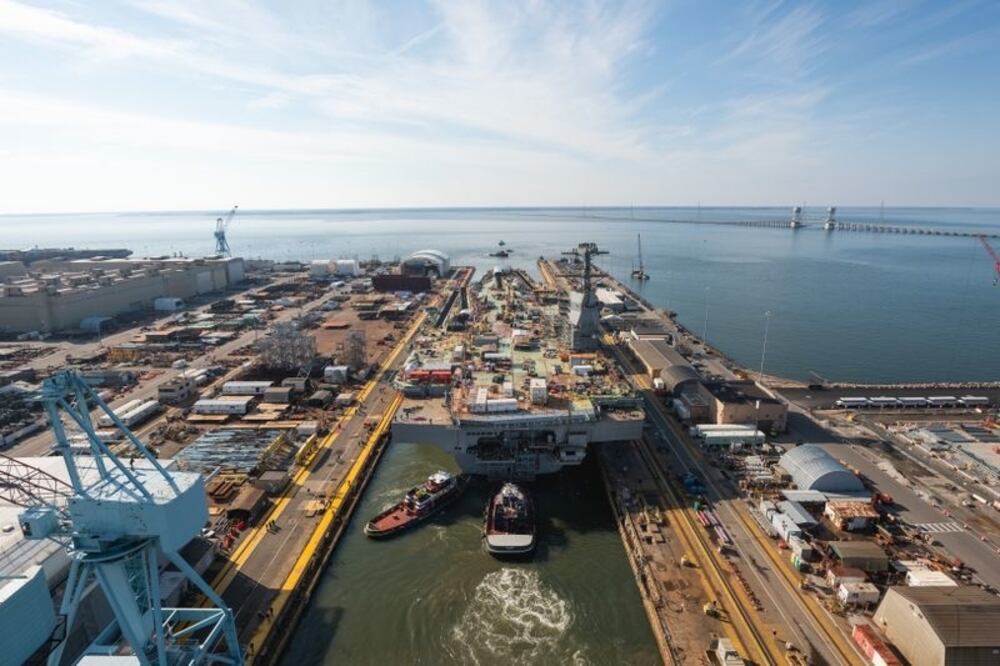WASHINGTON — As the American defense industry tries to assess the way forward under the new coronavirus pandemic, it should keep a close eye on the lower tiers of its supply chain, analysts warn.
There are two key factors when considering supply chain logistics: production and delivery. On the production side, hurdles include the potential for workers to have to halt production work due to the spread of the virus — something that has happened, albeit temporarily, at F-35 production spots in Italy and Japan — as well as economic impacts.
Click here for complete coverage of the COVID-19 outbreak.
Paul Scharre, director of the Technology and National Security Program at the Center for a New American Security, said that trying to predict the supply chain’s future is like looking into a crystal ball that is zooming by your face at 100 mph.
“For companies that are predominantly defense companies, government money is likely to keep coming,” he said. “The real source of disruption is if there are statewide mandated shutdowns saying: ‘Don’t go to work.’ ”
Small businesses may feel the economic pain the most, and that could spell trouble down the road. A 2018 Pentagon report on the defense-industrial base warned of “domestic extinction” among the sole suppliers for critical industrial parts — shops that could fold under rough economic conditions as the world is seeing now.
For instance, there are only four American suppliers with the capability to manufacture large, complex, single-pour aluminum and magnesium sand castings needed to support American air power. Those suppliers “face perpetual financial risk and experience bankruptcy threats and mergers mirroring the cyclicality of DoD [Department of Defense] acquisition,” the report said.
And there is only one qualified source for the upper, intermediate and sump housing for an unnamed heavy-lift platform used by the Marines (potentially the CH-53 King Stallion) that around 2017 went through bankruptcy proceedings. “Without a qualified source for these castings, the program will face delays, impeding the U.S. ability to field heavy lift support to Marine Corps expeditionary forces,” the report said.
RELATED

Warned Martijn Rasser, a senior fellow at the Center for a New American Security: “For small business, a shutdown would be extremely difficult to get through because even with bailouts and economic stimulus, once those businesses close up, its really hard to get those started again.”
“If an airline goes out of business, the planes don’t disappear — you can start over. If it’s a highly specialized manufacturing company, those employees are going to disperse and try to find other work. So I think that’s something to be very cognizant of because of all the consolidation in the defense industry,” he added. “If they have to curtail operations for an extended period of time, it’s extremely difficult to get it going again.”
Transportation of goods is another potential issue to watch, particularly as the commercial aviation industry is shutting down huge chunks of its operations.
Noted Todd Harrison of the Center for Strategic and International Studies: “What if parts of our transportation sector shut down so parts can’t ship, or they’re late shipping?”
That may already be happening, with cargo carriers reporting increased demand for shipping goods globally. A Thursday report on industry trade publication Air Cargo World warned that the “air cargo industry is seeing daily slashes to airfreight capacity and massive jumps in rates due to the extensive number of passenger flights cancelled globally as part of the effort to mitigate the spread of COVID-19. As a result, space on most trade lanes is tight and some even have backlogs.”
Travel restrictions between countries could complicate issues, given the increasing global nature of the supply chain on programs such as the F-35 fighter jet.
A delay of parts getting from a tier 4 to tier 3 supplier could turn into a delay from a tier 3 to tier 2 supplier, and in turn could lead to a delay in delivery of a defense article to the Pentagon. Still, the delays don’t currently look likely to be too serious in context, said Byron Callan of Capital Alpha Partners.
RELATED

“You might see those delivery delays crop up this April, May, June, July. That’s conceivable,” Callan said. “But I think we’re talking about slight changes, nothing in the order of magnitude you’re seeing in airlines and then by virtue in commercial aerospace.”
Other factors can also lead to potential delays of selling weapons abroad. On Thursday, the U.S. State Department warned that as a result of staff teleworking for the foreseeable future, the Directorate of Defense Trade Controls may be slow in responding to industry’s needs regarding the International Traffic in Arms Regulations.
“Industry is advised of the likelihood of longer than normal processing times due to a reduction in the availability of staff in multiple organizations to review applications,” State said in a news release.
Long term, the virus may also result in a change in how America defines national security supply chains.
Rasser predicts that the coronavirus outbreak will result in a “complete rethink of what supply chains are completely vital to U.S. security.”
Until now, there was not much thought given to the supply chain security of pharmaceutical or medical equipment, where China is a major producer of the equipment needed, Rasser said. Coming out of this pandemic, “a first step once we get through this crisis is a whole-of-government effort, together with private industry, to really dive deep into our current supply chains and then determine which ones we should consider critical for U.S. national security overall.”
Added Scharre: “Two months ago, if there had been a bill in Congress saying we need to ensure U.S. hospitals are buying American-made masks, I would have said that was silly. This has hugely expanded the scope of things we now think of as critical to the health and safety of the nation.”
Joe Gould in Washington contributed to this report.
Aaron Mehta was deputy editor and senior Pentagon correspondent for Defense News, covering policy, strategy and acquisition at the highest levels of the Defense Department and its international partners.







